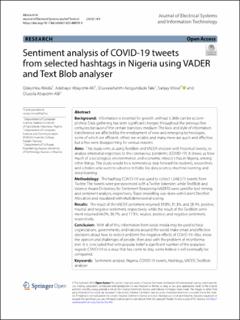| dc.description.abstract | Background: Information is essential for growth; without it, little can be accomplished. Data gathering has seen signifcant changes throughout the previous few centuries because of the certain transitory medium. The look and style of information transference are afected by the employment of new and emerging technologies, some of which are efcient, others are reliable, and many more are quick and efective, but a few were disappointing for various reasons. Aims: This study aims at using TextBlob and VADER analyser with historical tweets, to analyse emotional responses to the coronavirus pandemic (COVID-19). It shows us how much of a sociological, environmental, and economic impact it has in Nigeria, among other things. This study would be a tremendous step forward for students, researchers, and scholars who want to advance in felds like data science, machine learning, and deep learning. Methodology: The hashtag ‘COVID-19’ was used to collect 1,048,575 tweets from Twitter. The tweets were pre-processed with a Twitter tokenizer, while TextBlob and Valence Aware Dictionary for Sentiment Reasoning (VADER) were used for text mining and sentiment analysis, respectively. Topic modelling was done with Latent Dirichlet Allocation and visualized with Multidimensional scaling. Results: The result of the VADER sentiment returned 39.8%, 31.3%, and 28.9%, positive, neutral, and negative sentiment, respectively, while the result of the TextBlob sentiment returned 46.0%, 36.7%, and 17.3%, neutral, positive, and negative sentiment, respectively. Conclusion: With all of this, information from social media may be used to help organizations, governments, and nations around the world make smart and efective decisions about how to restrict and limit the negative efects of COVID-19. Also, know the opinion and challenges of people, then deal with the problem of misinformation. It is concluded that with popular belief a signifcant number of the populace regards COVID-19 as a virus that has come to stay, some believe it will eventually be conquered. | en_US |

